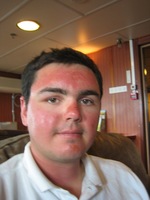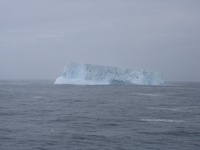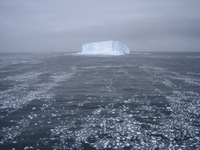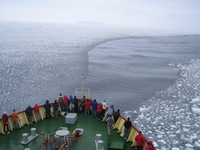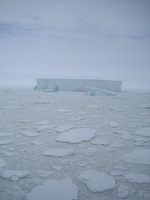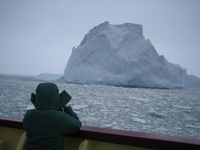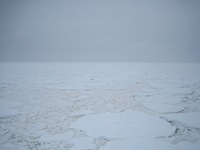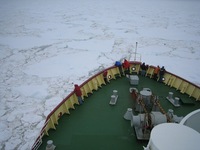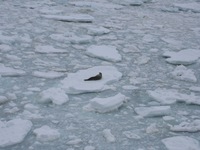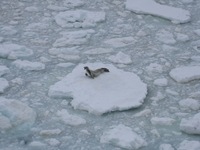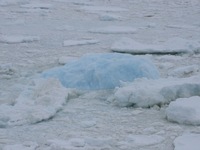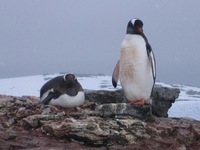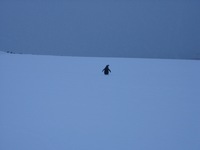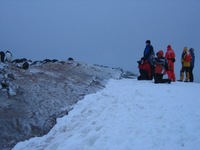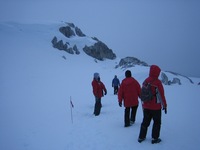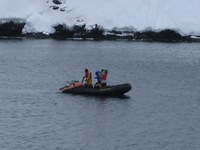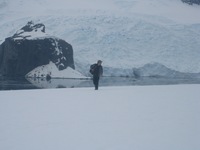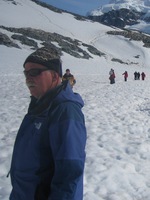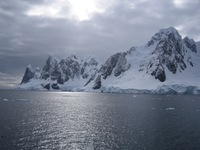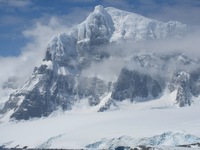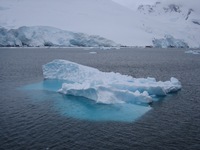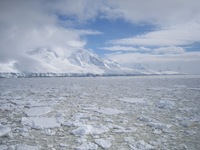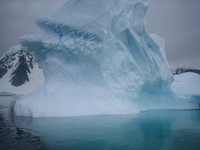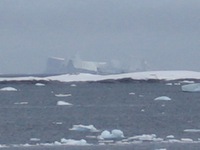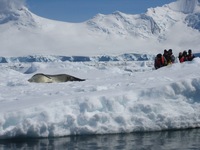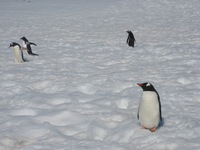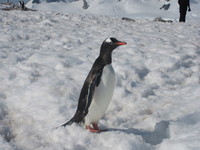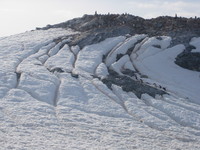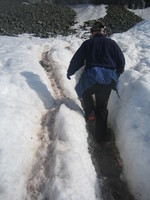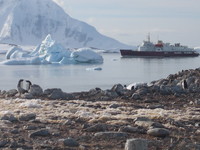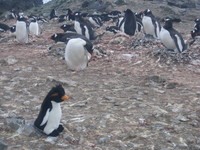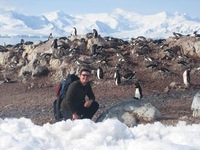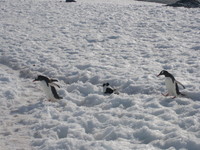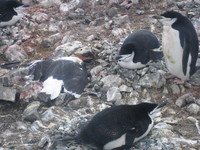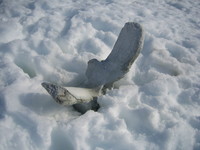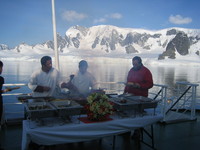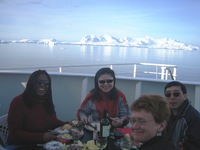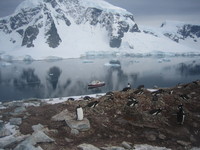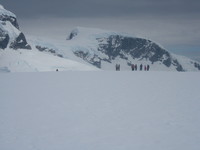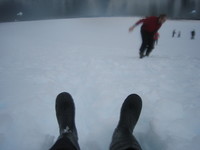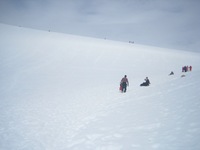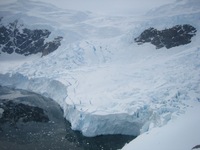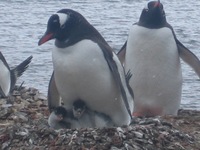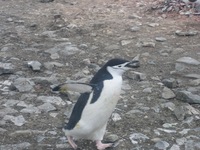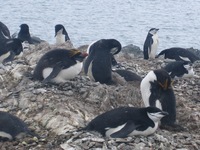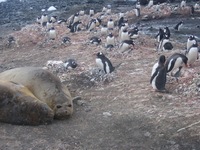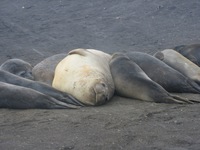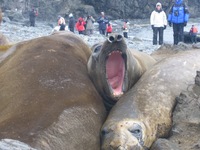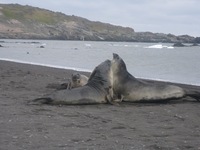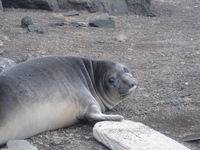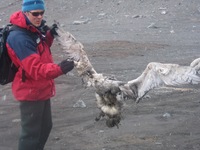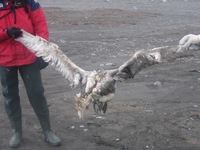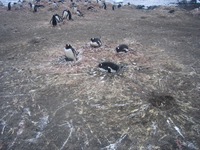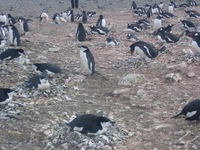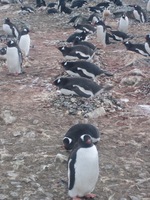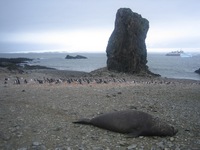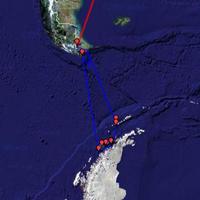My face fell off in Antarctica. Something to do with that whole “no o-zone” thing combined with me maybe not using as much sunscreen as I should have. I’m in the process of growing a new one. It hurts.
The first day it was just plain old sore. The ship’s doctor said there was nothing I could do and I should let it run its course. On reflection, I don’t think her advice was particularly merciful or well-considered.
When I woke up the next morning, my face felt like wax paper. It was dry and dead and itchy and I had a strong urge to pull the whole thing off. I caved to that urge, and it did in fact peel off in long strips. Remember that scene in The Fly when Jeff Goldblum is yanking off his ears and teeth and storing them in his medicine cabinet? Yeah, just like that.
…it seemed like a good idea at the time.
Once the new skin had enough exposure to the air, I began feeling a constant, excruciating pain all over my face – sort of like it was being pressed against a hot stove. That lasted about a day.
I considered wandering the halls, knocking on cabin doors and asking other passengers if they had any aloe. But I was worried they might mistake me for a zombie.
“Aim for the head! Kill the brain!”
Instead I just hid in my cabin.
After the new layer of skin had adjusted to its external role, the pain went away, and what I’m left with now is a red, swollen, scabby, flaky Halloween mask.
Sorry, ladies. As I’ve mentioned before, I’m taken.
On the ship, everyone already knew what I normally looked like, so they could shudder in horror with the knowledge that I’d eventually return to my stunningly handsome self. But I’ve just disembarked the ship and out here in the general population, it’s unclear whether or not I have a chronic rotting flesh disease. Folks pretend not to notice, which just makes it more obvious how sickening I appear.
Here’s the most grotesque detail of the whole ordeal. Skip this paragraph if you’ve had enough…ready?…when I still had the dead layer of skin, my sweat could no longer penetrate through the pores, so it formed in boil-like pools along my forehead and dripped out as a viscous, yellow syrup.
Who’s up for a change in subject? You are? Okay, then.
It was only moments after my last post that we spotted our first iceberg. The crew made much hay of this event, and I didn’t understand why until it happened.
As soon as the first one is spotted, things change very quickly.
We entered a strange new environment that I’ve never seen in photographs and never knew existed.
It was as if we’d invaded someone’s dream space. An infinite realm of the mind. And we were cutting through it like a butter knife.
But as any viewer of nature documentaries knows, no desert is barren. This is not a dead place. There are plenty who live quite comfortably out here.
The blue stuff is glacial ice. It takes that color after thousands of years, once all the air pockets have been squeezed out of it. It’s of a purity that is never seen in the seasonal world.
The whiter stuff around it is pack ice, composed largely of frozen salt water.
In a time when you can hop on a plane and reach virtually any place on the planet within two days, it’s important to appreciate the Odyssian hurdles that must be overcome in order to reach Antarctica; three grueling days across the Drake Passage followed by miles of thick, pitiless ice. It wasn’t challe nging for me per se — the ship did all the work — but it was a satisfying thing to watch.
Within a few hours, we’d penetrated through and reached Peterman Island; our first landing site and, at 65 degrees latitude, the southernmost point of our trip. From Peterman, we turned around and headed north up the Antarctic coast.
Because of our lost time, it was 9pm when we started the landing, but it didn’t look any different from noon. We were far enough down that the sun never set at all.
Peterman Island is filled with penguins.
These are the first of many penguin pictures, and believe me I’m exhibiting tremendous restraint by not including more. Penguin pictures are very very easy to take, as they’re extremely photogenic and completely indifferent to the presence of humans. Up until about a century ago, these birds had never encountered our species before and never been exposed to our thuggish behavior. As a result, they have no instinctive fear of us. We don’t look anything like killer whales or leopard seals, so we pretty much don’t exist.
The picture-taking orgy was interminable.
Some of our party broke off and wandered across the island to see what there was to see.
The expedition staff always landed before us and set down bamboo markers that defined our outer boundaries. We had a couple hours to explore.
I never once regretted wandering around on any of the landings. There was always some amazing mountain or glacier or snow dune to see.
We picked up three researchers. They’d been there for a month, doing pretty much the only thing there is to do on Peterman Island, which is count penguins. Their arranged pick-up hadn’t been able to reach them for some reason, so we gave them a ride. One of the researchers was from Portland, a hip town only a couple hours south of where I live in Seattle.
We commiserated about how great Powell’s book store is.
Amongst the passengers of our ship was a team of six South Africans led by a guy named Lewis Pugh. Lewis has a thing for swimming in really cold water. He came to Antarctica to break the world record for the southernmost long-distance swim.
He did it…in a Speedo.
He swam a full kilometer in 0 degree water (Celsius). They estimated that he could last 28 minutes before his body shut down. He did the swim in 18 minutes. Toward the end, his muscles seized up and he could no longer bend them. He crossed the finish line in a state that resembles rigor mortis.
The team accompanying him filmed for a documentary while researchers took measurements of his pulse, his muscle temperature — and as if the swim weren’t unpleasant enough — his rectal temperature.
It was all very interesting to watch.
I had two roommates in my cabin and I enjoyed them both a great deal.
Xiaonan is from Shanghai, but he lives in DC. He works for the World Bank and has a PhD from Harvard. He speaks with an accent, and if he’ll forgive me for saying so, his speech patterns are very similar to those of Long Duk Dong from Sixteen Candles.
I say that not to belittle. It’s just that sometimes folks have a way of talking that makes amusing comments even more amusing. Such as:
“Watch out you don’t slip on a penguin poop and fall on your face.”
This is the best I can come up with for a picture.
This is Sandy. Sandy is a law professor. He’s thoughtful and wise and he’s been just about everywhere. Literally, everywhere. I don’t think I’ve visited a spit of land on this entire planet he hasn’t already been to.
Wanna know how cool Sandy is: he went to Antarctica by himself and he didn’t bring a camera. He just walked around, looked, read, listened, and took it all in.
Here’s a guy who’s got things figured out. Here’s a guy who knows what’s important. Here’s a guy who knows where his towel is.
The next morning we went through the Lemaire Channel.
Way off in the distance, I’m pretty sure I saw Superman’s Fortress of Solitude.
I would’ve liked them to take us closer, but if they did that, I suppose it wouldn’t be much of a Fortress of Solitude, would it?
Our second landing was to be at Port Lockroy. While standing on the deck of the ship, an extremely elderly and hearing impaired couple had this exchange:
“Where are we going next?”
“Port Lockroy.”
“Fort Lockerbie?”
“Port Lockroy.”
“Port Loverboy?”
“Port Lockroy!”
“Port Lockjoy?”
“Port Lockroy!”
It’s the little pleasures, too. Not just the big ones.
The most remarkable thing about Port Lockroy is the tiny manned station near the shore with a working post office so people can send postcards. They also stamp passports. But we couldn’t reach it that day because of too much ice on the water.
Instead, they took us out on a 90 minute Zodiac cruise. Sandy instinctively knew to bow out, stay in the cabin and read. I wasn’t so sharp. The bottom line is they didn’t want to be accused of not giving us our money’s worth.
I just can’t stand being herded into a vehicle and carted around to look at stuff. It drives me crazy. I need to experience things for myself, or at least be presented with a plausible illusion of such. Instead, we were shown glacier after glacier until we were completely numb to the experience.
We did see this leopard seal, though.
Leopard seals are surprisingly vicious. Damon, the marine biologist on our expedition staff, had a harrowing encounter with one while he was working in Antarctica. He was diving over a hundred feet down with an air hose when a leopard seal happened upon the tube and started chewing on it. He reached the surface before the air flow was breached and was fine — but I imagine very shaken.
In 2003, his replacement at the research station had her leg bitten by another leopard seal while diving. She was dragged down until she drowned. This is the only known case of a leopard seal killing a human, and it has caused a sudden, well-founded wariness.
Later in the day we had our second attempt at a landing, this time at Cuverville Island. It was successful.
More penguins.
The penguins carve little trenches into the snow for themselves. It’s not a deliberate thing, just a welcome consequence of having oft-trodden routes between nesting spots.
Nevertheless, I can’t help but be reminded of Empire Strikes Back and wonder if, perhaps, they’re preparing for an invasion of AT-ATs.
Here we have a penguin path running directly adjecent to a people path.
Is there no limit to the adorability of these strange birds? Must everything they do be so agonizingly cute?
I caught this iceberg doing an impression of our ship to amuse the other icebergs.
“Okay okay, ready? What am I?…Get it? I’m the ship! See with the deck and the bridge and everything? I’m the ship! Pretty good, huh? Okay, your turn.”
I purchased a stuffed penguin doll on the ship to give to my niece for Christmas. I promised it to her before leaving, and she’s already named it Poopy Pants. I tried integrating it with the penguin population. They were as utterly indifferent to it as they were to us, and to pretty much everything that isn’t actively trying to eat them.
Here’s an example of something penguins are not indifferent toward.
Take pictures all you want, but mess with an egg, and you WILL get pecked to death.
Lest we forget what an alien place this is, here’s one of many giant whale vertabrae scattered around on all the beaches.
At the end of the second day of landings, the ship anchored in the stunningly scenic Paradise Harbor and we marked the halfway point of the cruise with a fabulous outdoor barbecue.
It felt decadent to be feasting in such a way amidst one of the harshest environments on earth. We should have been hacking off limbs and slaughtering sled dogs to survive. Instead we were hacking off marinated pork ribs and debating whether the salmon or steak was superior.
And Shackleton turns once more in his grave.
Next stop, Danco Island, with a short, steep hike up to 500 feet for an incredible panorama view of the region.
It doesn’t sound like much of an ascent, but when every third step sends you plummeting waist-deep in snow, it’s quite a workout. Only a dozen or so passengers met the challenge.
At the top, exhausted, the thought of hauling our asses back down was too much to bare, so most of us just sat down, pushed off, and slid on our asses instead.
Impromptu sledding down a hill in Anarctica. It’s one of those moments that crystallizes in your memory. This world is not all bad. It’s worth getting up each day, cause sometimes things like this will happen.
Our afternoon landing on the third day was at Neko Harbor. This was the only stop on our trip that actually took us to the continent of Antarctica proper, rather than an adjacent island. The experience itself wasn’t much different, but it was an important distinction to many passengers – myself included. Now we could say we’d actually BEEN to Antarctica.
The shore at Neko immediately gives way to a steep slope of pure, untouched snow.
It didn’t stay untouched for long. The more spry and nimble among us had caught the sledding bug that morning and we weren’t going to miss another opportunity.
Many regretted not bringing skis and snowboards.
Up at the top of the hill is a perfect rock outcropping that overlooks the glaciers jutting out along the bay. It being one of the warmest days in the southern hemisphere, the glacial calving was in high gear. A few of us sat on the outcropping and watched as huge chunks of ancient ice crashed into the water, their apocalyptic sounds echoing across the channel.
I figured this was a pretty good opportunity to do that dancing thing — capture the grandeur of the setting and all that. But I couldn’t really ask all the people sitting there to go away so I could dance.
Instead I waited, while the unfiltered Antarctic sun beat down on my skin…
…and waited…
…and burned…
Eventually, everyone else sledded their way back down the hill and it was just Jørn, the expedition leader, and myself. I’d shown Jørn the video and he was more than willing to hold the camera for me. I got the clip, and it’s a great clip, but I paid a high price for it.
Of course, it wouldn’t have been so high if I’d thought to wear sunscreen.
By the next morning, I was out of commission. I missed the landing on Deception Island – a submerged volcanic crater with pockets of water that are actually warm enough to swim in. It was an opportunity to strip down to bathing suits and lie in the Jacuzzi-like jets of lava-heated ocean, embracing the geological strangeness. Instead I just stayed in my room and embraced the agony of my stupidity.
I also missed a five kilometer hike around the rim of the volcano. Oh, well.
By the evening, after the burn had settled but before the peeling had begun, I decided I was well enough to go on the last landing at Livingston Island, a good distance north of the Antarctic peninsula and into the South Shetlands.
The ever-present penguins were, as ever, present. We’d seen many nesting atop their eggs in previous days. On occasion, we’d see parents swapping places in a fashion we were all now familiar with from March of the Penguins. We also saw one or two eggs that had frozen, and others that had been broken into by predatory birds. But Livingston Island was the first and only time we saw baby penguin chicks.
Cute overload…higher functions failing…logic and reason shutting down…must make winsome groaning sounds…
And Livingston had more than just the gentoos and adelies we’d been seeing everywhere else. They share the island with the even-more-grotesquely-adorable chinstraps…
…and the over-the-top ridiculous, clown-haired macaroni penguins.
The different penguins live in harmony along with an enormous number of not-at-all-un-enormous elephant seals.
The seals had come to shore because they needed to molt (incidentally, so did I). To do this, they would pile into massive heaps and, from time to time, roll back and forth to scratch themselves against each other in a mutually beneficial fashion.
These seals are all male, which explains the belching and farting. They’re young and fairly small for their species. They come here to eat krill and bulk up, so they can head back to their spawning grounds on South Georgia Island and make a bid for a harem.
Only the largest, most powerful male elephant seals are able to reproduce, and those that earn the right can take as many as 60 or 70 brides, while the vast numbers that can’t cut it learn to use computers instead and go to work for software companies.
When a male elephant seal is full-sized it weighs as much, if not more, than its namesake.
These guys are sparring to get ready for the big event. It’s a fairly pathetic display, as neither seal can really do anything to the other. I anticipate that the first seal to develop a stiff uppercut will have a massive evolutionary advantage that soon propagates throughout the species.
It’s interesting to note that a century ago, sailors looked in the eyes of creatures like this one and thought, “I will go grab a club and beat this thing’s head in until it is dead. Then I will remove its skin, as I am sure there is someone who would like to buy it from me.”
Here is the thing with Krill: it’s the favored meal of just about every large animal living in Antarctic waters. It’s the bottom of an amazingly flat food chain. You’ve got some predatory birds feeding on penguin eggs, orcas and leopard seals feeding on full-grown penguins, but aside from that it’s pretty much krill for breakfast, krill for lunch, krill for dinner – for everyone, forever.
Krill are dull, shrimpish creatures that grow to no more than a few inches in length. They’re filled with fluoride, which gives them a taste that is, to human palettes, unbelievably awful. Whales, seals, and penguins obviously feel differently.
Jørn spotted this fella and picked it up to show us its size. It’s a giant petrel. He deduced that it had died of a neck wound within the last couple days.
Splattered penguin poop looks remarkably like aboriginal folk art.
Chinstraps on the left. Gentoos on the right. It’s Penguin West Side Story.
This just reminded me of a bunch of fighter planes on a runway. That’s all I have to say about that.
I wish I had a video to convey this tragicomic image. The elephant seal is slowly making its way to water, a few feet at a time, then recuperating for several minutes between each lunge. It crawled from one edge of the frame to the other in about as much time as it takes to watch an episode of The Simpsons — which is, in some circles, a standard unit for the measurement of time.
Small wonder the sealers almost wiped these guys out in the span of a couple decades.
So that was it. After Livingston we headed due north, back across the Drake Passage. It was a much easier and less eventful crossing this time, with swells a small fraction of the twenty foot monsters we’d seen a few days before.
My skin fell off, which you’ve already heard plenty about, and here I am in Ushuaia. My flight to Buenos Aires leaves in the afternoon, then through Dallas and back to Seattle.
Here’s a map of the cruise:
If you’re interested, you can see the names of each destination by going to my map page, zooming in close on this region, and clicking on the little red balloons.
I’ll be home for the holidays, then at the start of the new year my lady-friend and I are leaving on a much, much longer trip. More on that later.
